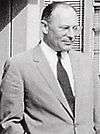Helmut Hölzer
Helmut Hoelzer[5] was a Nazi Germany V-2 rocket engineer who was brought to the United States under Operation Paperclip. Hoelzer was the inventor and constructor of the world's first electronic analog computer.[6]
Helmut Hölzer (English: Hoelzer) | |
|---|---|
 Helmut Hölzer in Huntsville, Alabama | |
| Born | February 27, 1912 |
| Died | October 12, 1996 (aged 84) Huntsville, Alabama, United States |
| Alma mater | Technische Hochschule Darmstadt |
| Known for | Designing an electronic simulator for the V-2 rocket control system.[1][2] |
| Scientific career | |
| Fields | Electrical Engineering,[3] Applied mathematics |
| Institutions | 1933-tbd: teaching 1939: Telefunken (Berlin) |
Life
In October 1939, while working for the Telefunken electronics firm in Berlin, Hoelzer met with Ernst Steinhoff,[7] Hermann Steuding, and Wernher von Braun regarding guide beams for a flying body.[Neufeld 1] In late 1940 at Peenemünde, Hoelzer was head of the guide beam division[Neufeld 2] (assistant Henry Otto Hirschler[8]), which developed a guide-plane system which alternates a transmitted signal from two antennas a short distance apart, as well as a vacuum tube mixing device (German: Mischgerät)[9] which corrected for momentum that would perturb an object that had been moved back on-track.[Neufeld 3] By the fall of 1941, Hoelzer's "mixing device" was used to provide V-2 rocket rate measurement instead of rate gyros.[Neufeld 4]
Then at the beginning of 1942, Hoelzer built an analog computer to calculate and simulate[8][10][11] V-2 rocket trajectories[Neufeld 5][12] Hoelzer's team also developed the Messina telemetry system.[3] After evacuating Peenemünde for the Alpenfestung (Alpine Fortress), Hoelzer returned to Peenemünde via motorcycle to look for portions of his PhD dissertation[5] prior to surrendering to United States forces at the end of World War II.
Hoelzer was a student of Alwin Walther.[6]
Family
One of his grandchildren is Olympic swimmer Margaret Hoelzer.
References
- Tomayko, James E. "Computers Take Flight: A History of NASA's Pioneering Digital Fly-by-Wire Project" (PDF). p. 13. Archived from the original (PDF) on 2004-07-19. Retrieved October 18, 2008.
- Tomayko, James E. (July 1985). "Helmut Hoelzer's Fully Electronic Analog Computer". Annals of the History of Computing. 7 (3): 227–240. doi:10.1109/mahc.1985.10025.
- Wade, Mark. "Hoelzer". Astronautix. Retrieved October 19, 2008.
- June 6, 1960
- Ordway, Frederick I, III; Sharpe, Mitchell R (1979). The Rocket Team. Apogee Books Space Series 36. New York: Thomas Y. Crowell. pp. 46, 294. ISBN 1-894959-00-0.
- Biener, Klaus (August 1999). "Alwin Walther – Pionier der Praktischen Mathematik". RZ-Mitteilungen. doi:10.18452/6275.
- Ernst Steinhoff
- H. Otto Hirschler, 87, Aided Space Program
- Ley, Willy (1951) [1944]. Rockets, Missiles and Space Travel (Revised edition 1958). New York: The Viking Press. p. 257.
- Neufeld, Michael J. (2013-09-10). The Rocket and the Reich: Peenemunde and the Coming of the Ballistic Missile Era. Smithsonian Institution. p. 138. ISBN 9781588344663.
- Ulmann, Bernd (2013-07-22). Analog Computing. Walter de Gruyter. p. 38. ISBN 9783486755183.
- Tomayko, James E. (1985). "Helmut Hoelzer's Fully Electronic Analog Computer". IEEE Annals of the History of Computing. 7 (3): 227–240. doi:10.1109/MAHC.1985.10025.
Sources
- Neufeld, Michael J (1995). The Rocket and the Reich: Peenemünde and the Coming of the Ballistic Missile Era. New York: The Free Press. pp. 104, 106, 107, 140.
- p. 107
- p. 140
- p. 104
- p. 106
- p. 106